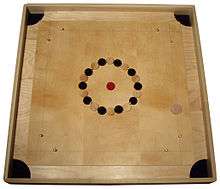Pitchnut

Pitchnut is a wooden tabletop game of French Canadian origins, similar to carrom, crokinole and pichenotte, with mechanics that lie somewhere between pocket billiards and air hockey. Unlike with pichenotte, there are no records of pitchnut being mass-produced; all existing boards are handmade and frequently handed down from generation to generation. The game is common on the farming villages south of Sherbrooke, Quebec, Canada and Amherst, Massachusetts, United States.
Origins

Very little about the history of the game has been written. Crokinole historian Wayne Kelly states that the game may be one of many efforts to combine crokinole with pichenotte, the French Canadian version of carrom. A similar board was patented in 1893 by E.L. Williams, but that game board had 8 pegs in the center of the board (like crokinole) but had only one peg in front of each pocket. Wayne Kelly's crokinole.com web site shows an image of a board that looks very similar to pitchnut (called "improved crokinole"), but the pegs in front of the pockets take the form of a wicket through which the players had to shoot their pieces, according to Mr. Kelly. Pitchnut was primarily played in the farming villages around Coaticook, Quebec, where Achille Scalabrini built the games during the twentieth century. As descendents of those villages moved to small cities and the U.S., the game has spread. High school teacher Lee Larcheveque has built more than 160 pitchnut boards. His former students have brought their boards to colleges across the United States.
Equipment

The game is played on a wooden board, normally 28 inches square. It differs from carrom and pichenotte boards in that it has a 2-inch gutter along the entire circumference of the board. Eric Harbec, a pichenotte player in Sherbrooke, Quebec, theorizes that the recessed gutters were added to direct playing pieces toward the pockets. In Carrom or pichenotte, a piece that is struck will not be guided towards the pockets. Pitchnut also has 4 pegs (or "screws") in the center of the board and two pegs in front of each pocket. The game is played with small disks (crokinole pieces or wooden checkers).
The object of the game is to finger-flick a comparatively heavy disk, called a striker, shooter or pitch, such that it contacts lighter object disks and propels them into one of four corner pockets. The pieces come in two sets, usually white and black, denoting the two players (or, in doubles play, teams). An additional piece is colored (red and green are common) and called the "poison", which is the puck equivalent of the eight ball in pool games.
Rules

The goal is to sink all of one's object pieces and the "poison" or "dame" before one's opponent does.
Play begins with alternating ten differently colored pieces in a ring in the center of the board. Five pieces fit between each peg. An off-colored piece (poison) is placed in the center of the board.

There are two main variations in rules- Canadian and American, though rules may also vary among families. In all variations, object pieces must be struck with a larger shooter. The shooter must remain either entirely or half way behind each player’s home line. The shooter must be returned to the home line before each shot. In American pitchnut the shooter may be placed in the side gutters, in Canadian pitchnut, it may not.
The shooter is usually shot with the index or middle finger and thumb in a flicking action ("pichenette" in French). The shooter may be pushed briefly with a finger, in a shoving motion, without the use of the thumb, but may not be pushed or dragged with the finger ("carried") across the player's home line.
American pitchnut is played with rules that are very similar to 8-ball pool. A player must pocket all of his/her pieces and then the poison. If the poison is sunk before all of a player's pieces are pocketed, that player loses. Games usually last around five minutes.
Canadian pitchnut uses the same rules as pichenotte, a similar game that does not have pegs or recessed gutters. The object is to score 50 points before your opponent does. A player earns five points for each of his opponents pieces that remain on the board. The odd-colored piece (dame) is worth fifteen points and can be shot in at any time (some rules require that a player "cover" the dame by immediately sinking one of his/her own pieces. Some families/regions play with two odd-colored pieces in the center. A game can consist of several rounds of play, and a game can last 20 minutes or more.
See also
References
External links
- Pitchnut website — with rules, events of the Amherst Regional High School Pitchnut Club, news, gallery